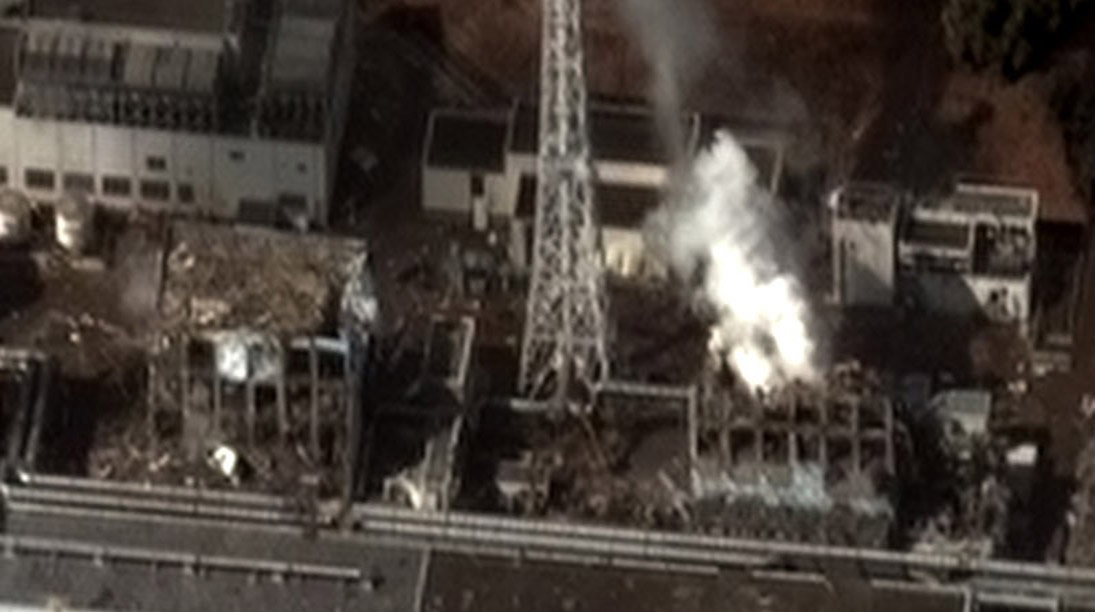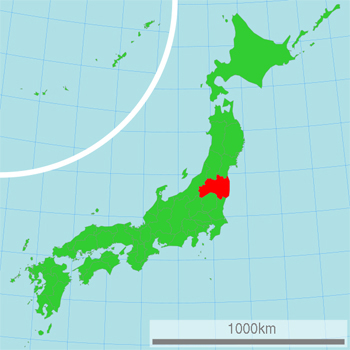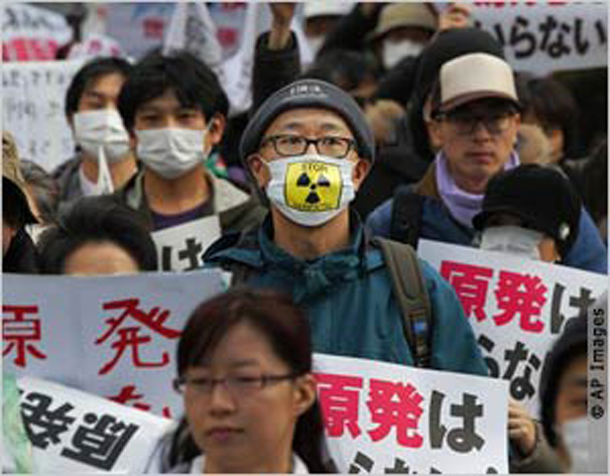Radioactive Water from Fukushima in the Pacific
Air Date: Week of July 26, 2013

Fukushima Reactors 3 & 4 after meltdown of 3 began. ( Wikimedia Commons)
More than two years after the Fukushima nuclear power plant in Japan had a meltdown following flooding from a tsunami, radioactive water is likely seeping into the Pacific Ocean. Argun Makhijani, President of the Institute for Energy and Environmental Research, tells host Steve Curwood that Japanese officials still don’t know how to contain the radiation fully.
Transcript
CURWOOD: Back in March of 2011, a huge earthquake off the coast of Japan caused a tsunami that crashed over the Fukushima nuclear power complex. One of the four reactors suffered a meltdown, and today radioactive material is still being released into the environment. Now there are new concerns that radioactive water is leaking into groundwater and ultimately flowing into the Pacific Ocean near the facility. Arjun Makhijani is President of the Institute for Energy and Environmental Research. We called him up to find out what type of radioactive material could be getting into the ocean.
MAKHIJANI: Well, they have got three different radionucleotides in large quantities and concentrations in the groundwater under the plant, which is strontium-90, which mimics with calcium, goes to the bone; cesium, which mimics potassium, goes all over the body; and tritium which is like water, so also goes all over the body. So these are quite mobile, strontium and tritium particularly, and so these are the ones that would wind up in the ocean and also in ocean life. But currently it’s unclear how much of the contamination is reaching the ocean.
CURWOOD: So how much might that radioactive water affect human health once it gets out into the environment?

Fukushima Prefecture is featured in red. (Wikimedia Commons)
MAKHIJANI: Well, the strontium-90 and the cesium would both be perilous, and since the strontium-90 is more mobile and also more dangerous biologically, strontium behaves like calcium, so it goes to the bone. It also bioaccumulates in the base of the food chain and algae. Ultimately because it does bioaccumulate and there is quite a lot of strontium, you could have a large part of the food chain near Fukushima being contaminated.
CURWOOD: Now, what happens to people who are exposed to strontium-90?
MAKHIJANI: The effects, of course, affect your chances of getting cancer all over the body, but specially in the organs that it targets. It’s like the bone and bone marrow. It’s a special problem I think for pregnant women because the stem cells of our immune system are formed in the bone marrow. So when the stem cells are being formed, if pregnant women drink contaminated water, or eat contaminated fish, the outcomes could be worse than cancer because then you’re talking about a much more compromised child in the sense of having a compromised immune system - it makes you more vulnerable to all kinds of diseases.

A large area around the Fukushima nuclear facility will be uninhabitable for generations.
CURWOOD: Now, it’s been two years since this accident, but this nuclear meltdown reactor is going to be hot for quite a long time. Just how long will it be super hot?
MAKHIJANI: Well, the cesium and the strontium have half lives of about 30 years, so we’re talking several hundred years there. But there are, of course, other materials, like plutonium, which has a half life of 24,000 years and so on. There are fission products that have half lives in the millions of years so you’re talking about radioactivity that’s essentially forever. And you know Chernobyl, where there was an accident in 1986, has become a permanent waste dump. It’s very, very unclear to me how they are going to be able to get at this molten fuel, extract it from the bottoms of these highly damaged buildings and package it for safer or less dangerous storage or disposal. Right now, they’re still, two years later, trying to contain the situation on an emergency basis.
CURWOOD: As I understand it, of the 50 or so nuclear reactors that Japan had before the Fukushima disaster, 48 or so of them have been shut down. So how is Japan getting electricity in the meantime? And what are, do you think, the government’s plans to start up nuclear plants again in Japan?

TEPCO has admitted that radioactive water from the Fukushima nuclear facility is likely leaking out of the plant and making its way to the ocean.
MAKHIJANI: Well, they had 54. Of course, four were damaged by the accident. And so that leaves 50, and two are operating as you said. There’s a lot of public resistance to opening the others. So they’re getting their energy from a number of sources. First of all, they’ve got a highly coordinated conservation program. They’re importing more fossil fuels. And they are trying to rapidly increase their renewable energy production - both wind and especially solar. But the government policy of the present prime minister is to restart the reactors.
CURWOOD: So, now more than two years since the Fukushima accident, and the problem seems to be far from contained, how can the Japanese get a handle on this going forward from here?
MAKHIJANI: It’s very, very unclear in terms of what is going to happen with Fukushima. Of course, it is in a seismic zone, so one of the big dangers is this highly radioactive waste sitting in these pools. If that infrastructure that is now damaged becomes much more damaged, then the devastation could be quite great, and much more of it could wind up in the oceans. I mean, they have millions and millions of gallons of radioactive water that is stored in tanks on site, near the site, and they’ve been building tanks like they’re going out of style and they just cannot keep up. And they have no idea what they’re going to do with these millions and millions of gallons of contaminated water, and that’s just one of the problems. The other one is, they’ve got this molten fuel at the bottom of these reactors. It’s going to be extremely difficult to get at it. So, the general idea is that it’s going to take them decades - this is an accident that’s shockingly not stopping - even the emergency is not over.
CURWOOD: Arjun Makhijani is President of the Institute for Energy and Environmental Research in Maryland. Thank you so much, Arjun.
MAKHIJANI: Thank you, Steve.
Links
Living on Earth wants to hear from you!
Living on Earth
62 Calef Highway, Suite 212
Lee, NH 03861
Telephone: 617-287-4121
E-mail: comments@loe.org
Newsletter [Click here]
Donate to Living on Earth!
Living on Earth is an independent media program and relies entirely on contributions from listeners and institutions supporting public service. Please donate now to preserve an independent environmental voice.
NewsletterLiving on Earth offers a weekly delivery of the show's rundown to your mailbox. Sign up for our newsletter today!
 Sailors For The Sea: Be the change you want to sea.
Sailors For The Sea: Be the change you want to sea.
 The Grantham Foundation for the Protection of the Environment: Committed to protecting and improving the health of the global environment.
The Grantham Foundation for the Protection of the Environment: Committed to protecting and improving the health of the global environment.
 Contribute to Living on Earth and receive, as our gift to you, an archival print of one of Mark Seth Lender's extraordinary wildlife photographs. Follow the link to see Mark's current collection of photographs.
Contribute to Living on Earth and receive, as our gift to you, an archival print of one of Mark Seth Lender's extraordinary wildlife photographs. Follow the link to see Mark's current collection of photographs.
 Buy a signed copy of Mark Seth Lender's book Smeagull the Seagull & support Living on Earth
Buy a signed copy of Mark Seth Lender's book Smeagull the Seagull & support Living on Earth

